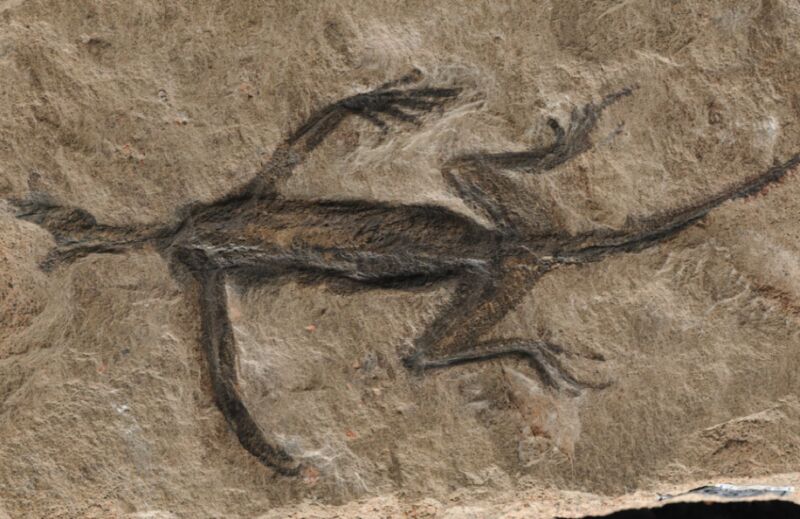
Valentina Rossi
For more than 90 years, scientists have puzzled over an unusual 280 million-year-old reptilian fossil discovered in the Italian Alps. It’s unusual because the skeleton is surrounded by a dark outline, long believed to be rarely preserved soft tissue. Alas, a fresh analysis employing a suite of cutting-edge techniques concluded that the dark outline is actually just bone-black paint. The fossil is a fake, according to a new paper published in the journal Paleontology.
An Italian engineer and museum employee named Gualtiero Adami found the fossil near the village of Piné. The fossil was a small lizard-like creature with a long neck and five-digit limbs. He turned it over to the local museum, and later that year, geologist Giorgio del Piaz announced the discovery of a new genus, dubbed Tridentinosaurus antiquus. The dark-colored body outline was presumed to be the remains of carbonized skin or flesh; fossilized plant material with carbonized leaf and shoot fragments were found in the same geographical area.
The specimen wasn’t officially described scientifically until 1959 when Piero Leonardi declared it to be part of the Protorosauria group. He thought it was especially significant for understanding early reptile evolution because of the preservation of presumed soft tissue surrounding the skeletal remains. Some suggested that T. antiquus had been killed by a pyroclastic surge during a volcanic eruption, which would explain the carbonized skin since the intense heat would have burnt the outer layers almost instantly. It is also the oldest body fossil found in the Alps, at some 280 million years old.
Yet the fossil had never been carefully analyzed using modern analytical techniques, according to co-author Valentina Rossi of University College Cork in Ireland. “The fossil is unique, so this poses some challenges, in terms of analysis that we can do when effectively we cannot afford to make any mistakes, i.e., damaging the fossil,” Rossi told Ars. “Previous preliminary studies were carried out in the past but were not conclusive and the results not straightforward to interpret. The incredible technological advancement we are experiencing in paleontology made this study possible, since we can now analyze very small quantities of precious fossil material at the molecular level, without the risk of damaging the whole specimen.”

Valentina Rossi
Rossi et al. focused on the dark body outline believed to be carbonized soft tissue for their analysis. This involved photographing the fossil—plus some fossilized plants found in the same area—in both white light and UV light, and using those images to build a photogrammetric map and 3D model. They also took minute samples and examined them with scanning electron microscopy, micro X-ray diffraction, Raman spectroscopy, and ATF-FTIR spectroscopy.
The entire specimen, both the body outline and the bones, fluoresced yellow under UV light; the plant specimens did not. But coatings like lacquers, varnishes, glues, and some artificial pigments do fluoresce yellow under UV light. There was no evidence of fossilized melanin, which one might expect to find in preserved soft tissue. Also, fossils with preserved soft tissue are typically flattened with little topography; the T. antiquus specimen showed a lot of topographical variation in the dark outline areas.
The authors thought this was consistent with some kind of mechanical preparation, perhaps to (unsuccessfully) expose more of the skeleton. They concluded that one or more layers of some kind of coating had been applied to the body outline and the bones. The granular texture of what had been presumed to be soft tissue was more consistent with manufactured pigments used in historical paintings—specifically, “a manufactured carbon-based pigment mixed with an organic binder,” i.e., bone black paint. Conclusion: T. antiquus is a forgery and scientists therefore should be wary of using the specimen in comparative phylogenetic analysis.

Zixiao Yang
How could scientists have presumed the dark outline was carbonized soft tissue for so many decades? “This fossil was discovered in 1931 and back then fossils were treated very differently than today,” said Rossi. “Application of paints, consolidates and lacquers on fossil bones was the norm, because that was the only way to protect the specimens from further deterioration. It was also sometimes to embellish specimens by making them sleek and shiny. Unfortunately, in the case of Tridentinosaurus, the mechanical preparation did most of the damage and then the application of a black paint created the illusion of a lizard-like animal impression on the surface of the rock.”
This analysis also casts doubt on the validity of the fossil’s assigned taxon, which was based on observations of the body proportion and measurements of limbs, neck, and abdomen. Part of the fossil, at least, appears to be genuine—the long bones of the hind limbs—but that doesn’t mean it will be easier now to determine species or where the specimen fits in the fossil record. “The bones that are recognizable appear to be very poorly preserved, so it might be very difficult to extrapolate any information,” said Rossi. “But perhaps the discovery of new fossil material from the same area where this specimen was found might help identify this ancient animal.”
So how can paleontologists prevent this kind of error from happening in the future? Rossi recommends reporting such finds via scientific journals with a detailed explanation of the methods that were used to characterize the surface materials on both the fossil and the rock. “It’s important to be aware that certain practices are not acceptable anymore, and not just because it creates—whether intentionally or by genuine mistake—misinformation and distorts our perception of a specimen,” said Rossi. “But also because the fossil will be irreparably damaged, and we might have lost key information about the original aspect and preservation state of the fossil.”
Paleontology, 2024. DOI: 10.1111/pala.12690 (About DOIs).




















+ There are no comments
Add yours